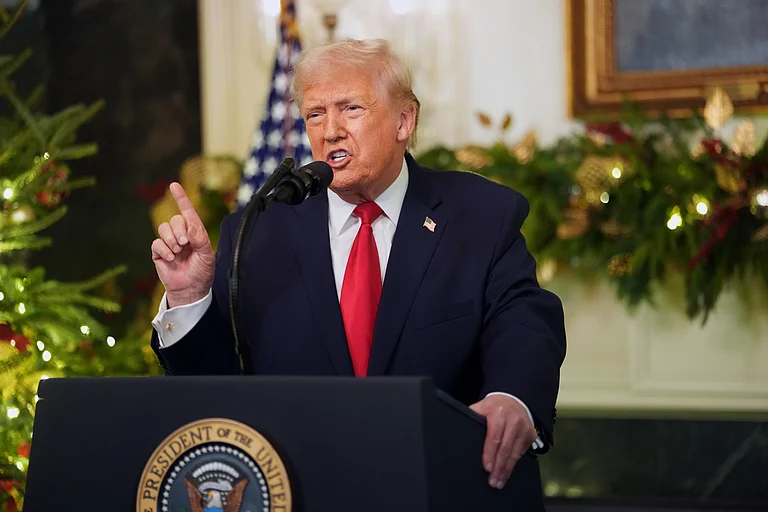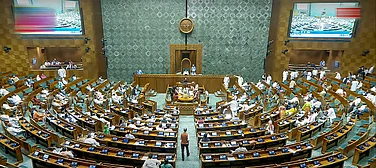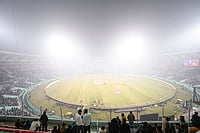While the United States has largely moved past the 9/11 attacks —to the extent that TikTokers are sharing Osama bin Laden's letter sympathetically— that's not the case with India and the 2008 Mumbai attacks. For one, India has never been able to bring the planners and facilitators to justice.
Ten years after Al Qaeda mounted the worst-ever attack on the United States, a US special forces team hunted down the group's chief, Osama bin Laden in Pakistan in 2011. Moreover, even though he has not yet been convicted, the principal architect of the attack, Khalid Sheikh Mohammad, was in US custody within two years. Sheikh, better known as KSM, was found living in a villa at a five-minute drive from Pakistan's military headquarters.
In India's case, the planners of the Mumbai attacks —better known as the 26/11 attacks— remain at large in Pakistan. The leaders of the Lashkar-e-Taiba (LeT) who planned the attacks and guided the terrorists throughout are out there in Pakistan and two key facilitators are in the United States. The Indian authorities are looking forward to extraditing one of them, Tahawwur Rana, to prosecute him in his role in the attacks.
As India marks a sombre 15th anniversary of the 26/11 attacks, we recollect how the Mumbai attacks played out and explore the Israeli connection as the country designated LeT as a terrorist organisation this week.
Planners in Pakistan, facilitators in USA, mayhem in Mumbai
Just seven years after the 9/11 attacks, the world witnessed another transnational terrorist plot in the form of the 26/11 Mumbai attacks. While the planners were based in Pakistan, key facilitators were based in the United States: David Coleman Headley and Tahawwur Rana.
On November 26, 2008, a total of 10 Pakistani terrorists arrived in Mumbai on a boat. They had left Pakistan on a Pakistani vessel and had hijacked an Indian boat after entering Indian waters. The Indian boat owner was killed. Once they arrived in Mumbai, they split and sought their targets, plunging the city into terror along the way. They attacked the Chhatrapati Shivaji Railway Station, Leopold Cafe, Cama Hospital, Nariman House, and Oberoi Trident and Taj Mahal Palace hotels.
The targets were selected for their practical as well as symbolic value. While the railway station provided an abundance of victims, the Taj Hotel is an iconic structure of Mumbai. The Nariman House building hosted a Chabad house, an outreach centre of the Jewish community. Along with India and the United States, LeT also considers Jews and Israel as prime enemy.
A total of 174 people were killed in the attacks and more than 300 were injured. The dead included 26 foreign nationals. The National Security Guards (NSG) teams were eventually deployed to free the hostages and take down the terrorists. Throughout their rampage, the terrorists were in touch with their handlers in Pakistan. They included the mastermind Sajid Mir, who not only guided them throughout but had also selected the targets. He is understood to have been backed by Pakistan's Inter-Services Intelligence (ISI), the all-powerful intelligence agency of the country. The other key Pakistanis believed to be involved have been identified as Major Iqbal and Pasha of ISI. Mir and Iqbal are also key to the story of a key US-based facilitator.
"Mir had spent two years using a Pakistani-American operative named David Coleman Headley to conduct meticulous reconnaissance on Mumbai, according to investigators and court documents. He had selected iconic targets and the Chabad House, a seemingly obscure choice, but one that ensured that Jews and Americans would be casualties," wrote investigative journalist Sebastian Rotella in a report.
In the West, Headley and Rana were running the LeT's show. Mir and ISI's Iqbal are understood to be the handlers of Headley, who is serving a 35-year sentence for his terrorist activities. In addition to being associated with LeT for years, Headley was also key to the reconnaissance of the targets in Mumbai as his US passport and Westernised name and looks provided him a good cover. Rana, whose custody India seeks, is accused of being aware of Headley's plans and facilitating his travel and lodging in Mumbai, which in turn facilitated the attacks.
Headley was an informant of the US Drug Enforcement Administration (DEA) who joined LeT sometime after 1999. Along the way, he was also helped by Rana, who had by then left Pakistan and had become a Canadian citizen. Fifteen years later, the failure of the US agencies to identify a terrorist and a key facilitator among their ranks and share the information accurately with India remains an irritant and one of the factors that fuels sporadic questions on the India-US security relationship. A ProPublica investigation found that Headley's wife had warned the US agencies thrice in 2007 and 2008 that he was working on a terrorist plot for Mumbai. The warnings were clearly not heeded.
Trail of errors in Mumbai attacks
In the past 15 years, a trail of errors and missed opportunities have emerged that enabled the Mumbai attacks.
The most glaring were the failures to act on multiple warnings of an attack that even pointed out that the LeT could attack via sea. In their book 'The Siege: The Attack On The Taj', Adrian Levy and Cathy Scott-Clark wrote that the US Central Intelligence Agency (CIA) had shared 26 intelligence alerts with India prior to the attacks.
"Three warnings specifically mentioned the use of fidayeen, meaning guerrillas armed with grenades and AK-47s who fought to the death, inflicting heavy casualties before being overcome...Eleven warnings suggested the plan would involve multiple simultaneous attacks. Six warnings pointed to a sea-borne infiltration, which would be a first in India," wrote Levy and Scott-Clark.
A Pro-Publica investigation found that "US agencies learned enough about him [Headley] to glean fragments of intelligence" that went into these warnings. The investigation also found that Headley's status as a DEA informant further bolstered his ability to do the job.
"U.S. and foreign officials say his role as an informant or ex-informant helped him elude detection as he was training in Pakistani terror camps and traveling back and forth to Mumbai to scout targets. And three counterterror sources say U.S. agencies learned enough about him to glean fragments of intelligence that contributed to the warnings to India about a developing plot against Mumbai," reported Pro-Publica.
While the US agencies could not detect a terrorist using their resources against India, there was another missed opportunity. For a considerable period of time, the intelligence agencies of India and United Kingdom (UK) were spying separately on one man named Zarrar Shah, who was the technology chief of LeT at the time and was responsible for arranging secure communication between terrorists and handlers in addition to doing research for the attacks. Investigative journalist Sebastian Rotella termed the failure to connect the dots as "among the most devastating near-misses in the history of spycraft".
"United States spy agencies also alerted their British counterparts, according to a senior American intelligence official. It is unclear if the warnings led to the targeting of Mr. Shah’s communications, but by the fall of 2008, the British had found a way to monitor Lashkar’s digital networks. So had the Indians. But until the attacks, one Indian official said, there was no communication between the two countries on the matter," reported Rotella for ProPublica.
Hope for justice 15 years later
Months before the 15th anniversary of the 26/11 attacks, a US court in May cleared the extradition of Canadian national Tahawwur Rana. His case is currently moving through the US higher court as he has appealed against the extradition.
Rana is already serving a 14-year sentence for his role in planning to attack a Danish newspaper that published cartoons of the Prophet Muhammad and supporting Lashkar-e-Taiba (LeT). But he was acquitted of any role in the Mumbai attacks. His longtime friend David Coleman Headley, however, pled guilty to being part of the Mumbai attacks and implicated him in his testimony.
Shortly before the 15th anniversary of the Mumbai attacks, the Israeli government designated LeT as a terrorist organisation. Notably, Israelis and Jews were deliberately targeted in the attacks. At Nariman House, four Israeli nationals were killed and a child was orphaned. As mentioned earlier, Nariman House was specifically chosen as a target because it housed a Jewish outreach centre. LeT and fellow terrorist organisations like Al Qaeda have often included Israel among their main targets and have at times clubbed India and Israel. For example, in 2019, Al Qaeda in its propaganda said it would take back Delhi and Jerusalem from "standard-bearers of injustice and infidelity", according to The Daily Pioneer.
From India to Israel and other countries that lost their citizens in the 26/11 attacks, the road to justice remains long as Rana's extradition remains in the pipeline. Even when he arrives in India, others like Hafiz Saeed, Zakiur Rehman Lakhvi, Sajid Mir etc., would remain out of reach in Pakistan.


























